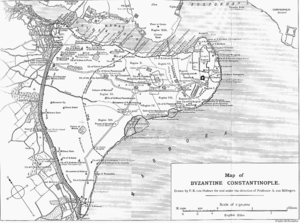Mangana Palace
The Mangana Palace in Constantinople was named after the nearby magazines (Mangana). These magazines, like the so-called 'New Tract', were built by Emperor Basil I (867-886), according to his biographer, Emperor Constantine VII (913-959), to store food for the imperial table and not to use the taxes for his personal support and "have the table set at the expense of others for the joy of those who have been invited by him throughout the year".
Parts of the palace
The monastery of St. George in Mangana was built by Constantine IX in the middle of the 11th century . Monomachus (1042–1054) founded as an extension of the Great Palace , as reported in the Chronicle of Theodoros Skutariotes and the Chronicle of Michael Psellos . The extensive complex lay on three terraces and was enclosed by a wall. It also contained a palace building, a garden and a hospital. The area was at least 800 m long, between the wall of the Topkapi Palace and the sea wall . Large cisterns supplied water for watering the garden and the baths. After Michael Psellos, the emperor changed the construction plan of St. George's Church three times to make it even more splendid. The monastery had a rich library.
The gardens of the Mangana were located above the palace and were so large that the surrounding wall could not be seen and one could ride around on horseback. According to Psellos (Chronographia CLXXIII), Constantine, who distributed his excess of intelligence equally to serious purposes and his amusement, had earth with the plants and bushes growing on it as well as whole trees with their fruits and roots brought from the mountains to create the garden. The emperor did not wait for the natural changes and the seasons, but created everything anew, like the creator himself. Constantine IX Monomachus was buried in Mangana in 1054.
Manuel I. Komnenos is said to have built a fortress tower on the island of Kız Kulesı in front of the opposite Scutari in order to be able to close the Bosporus with a chain. The other end of the chain was attached to a tower on the Mangana. However, it is not reported how the chain was held on the surface of the water. During the occupation by the Crusaders , John Mesarites found refuge in Mangana. From 1207 the monastery belonged to the Latins until Michael VIII. Palaiologos (1261–1282) recaptured Constantinople. In the 14th century, the abbot of Mangana received the title of Protosynkellos and was only inferior to the abbot of the studio monastery . As late as 1402, the monastery was surrounded by gardens, as can be seen in a description by the Spanish ambassador Ruy González de Clavijo . He also describes the multicolored floor of the church. After the city was captured by the Ottomans in 1453, the St. George's Monastery was looted and destroyed, and components were found in that of Mehmet Il. Fatih (1467) established seraglio use. The park was retained and provided with some buildings; a zoo was built in the eastern corner .
The construction of a railway caused severe damage and destroyed the apse of St. George's Church.
Important events that took place here
- When Emperor Alexios I was dying in the Mangana Palace on August 15, 1118, his son Johannes broke into the monastery with the help of his relatives, especially his brother, the Sebastokrator Isaak, and stole the imperial signet ring from his father's hand. Then he rode with an armed retinue into the Grand Palace , where the people proclaimed him emperor. This eliminated Nikephoros Bryennios , the husband and favorite of the imperial daughter Anna Komnena .
- ca. 1184: Konstantinos macro Dukas and Andronikos Doukas, for violation of the imperial majesty of Andronikos I. accused were stoned and the Manganapalast against impaled .
- The Patriarch John XI. Beccos (1275–1282), who advocated the unification of the Catholic and Orthodox Churches, found refuge for a time in St. George's Monastery in Mangana.
- The Patriarch Isaiah (1323-1334) was because of his participation in the dispute between Andronikos II and Andronikos III. imprisoned in the monastery.
- The emperor Johannes Kantakuzenos (1347-1354) retired to the monastery after his abdication and wrote theological and historical writings as a monk Joasaph.
- Markos Eugenikos , the Metropolitan of Ephesus , was buried here after his death on June 23, 1444.
Research history
The site was examined in 1921-22 by the French archaeologists Robert Demangel and Ernest Mamboury . In 1976, the Istanbul Archaeological Museum carried out rescue excavations to expand the railway line. During the restoration of the city walls, the Mangana area was also cleared and examined. Components of the Polyeuktos church as well as components that had already been described by Demangel and Mamboury were found.
literature
- Robert Demangel / Ernest Mamboury: Le quartier des Manganes et le premiere region de Constantinople , Paris 1939.
- Wolfgang Müller-Wiener: Bildlexikon zur Topographie Istanbul , Tübingen 1977, pp. 136-138.
- Alpay Pasinlı / Cihat Soyhan: Report on the Rescue Excavation in the Manganlar Region in 1976 , in: Ayasofya Müzesi Yıllığı 9 (1983) pp. 54-66.
- Henry Maguire: Garden and Parks in Constantinople , in: Dumbarton Oaks Papers 54 (2000) pp. 251-264 (text; PDF; 133 kB); ( Images ). PDF files
Web links
Coordinates: 41 ° 0 ′ 42.9 ″ N , 28 ° 59 ′ 13.5 ″ E
